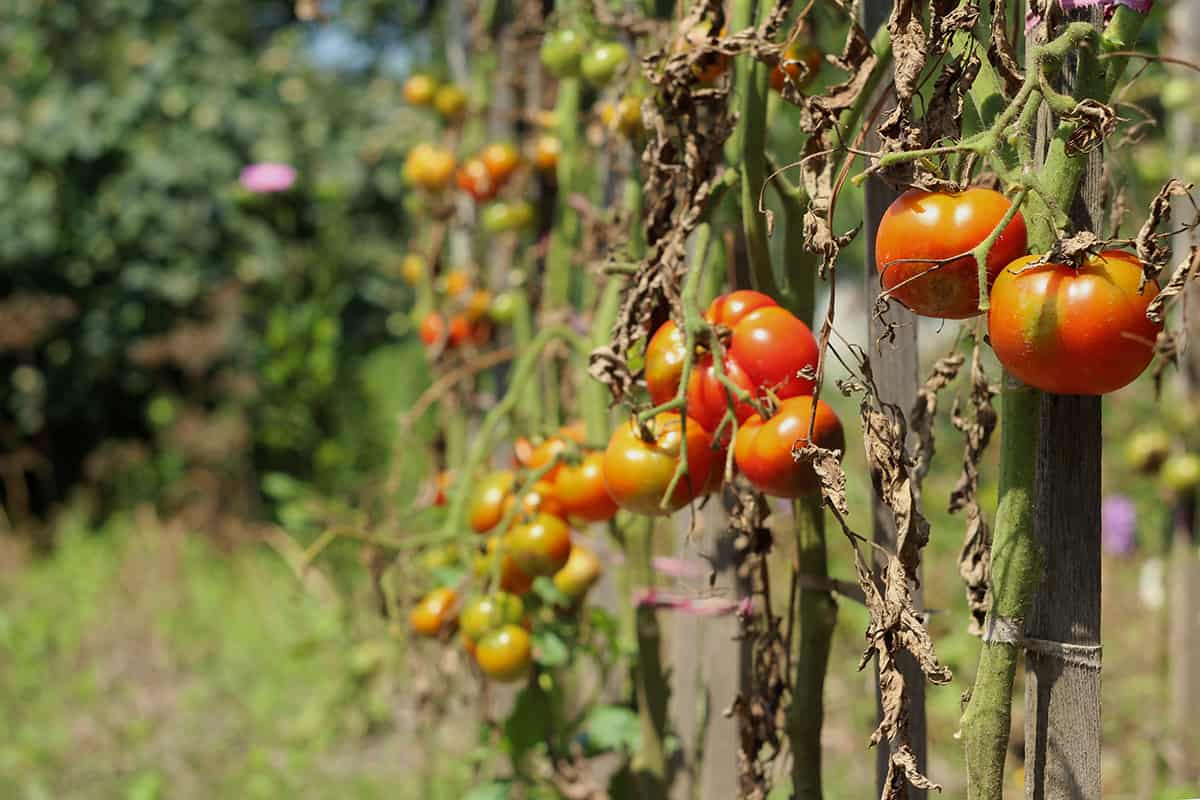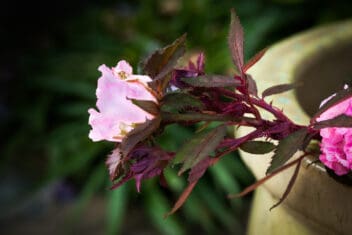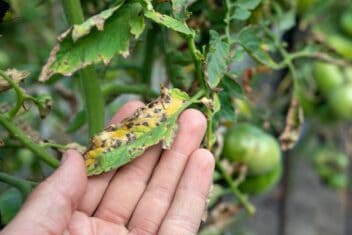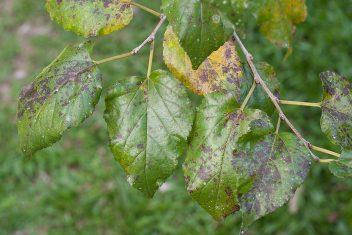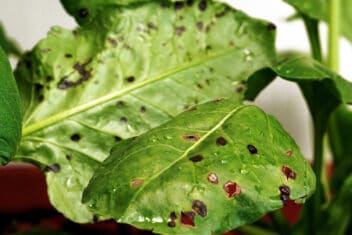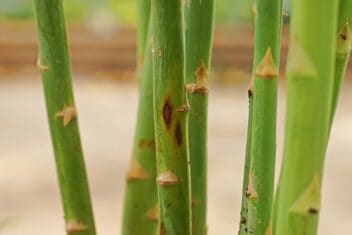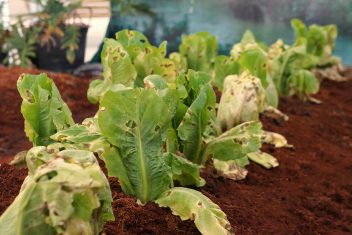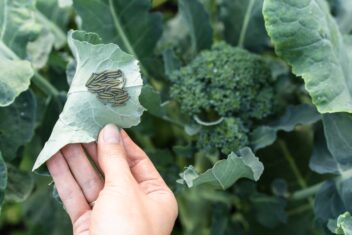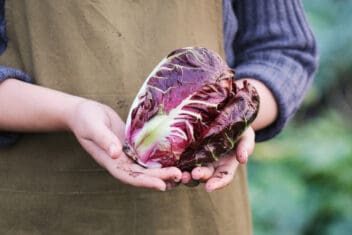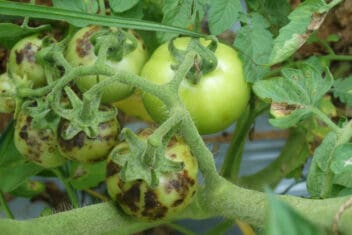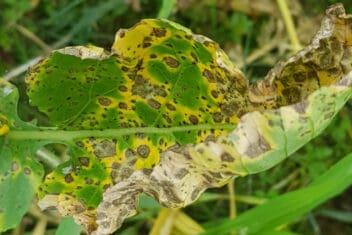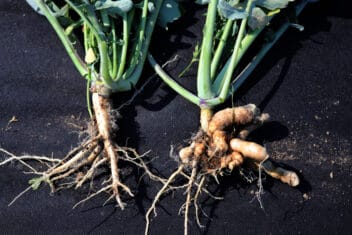Tomato plants are known for being vulnerable to a number of tomato diseases. Fungal, viral, and bacterial issues can wipe out entire crops and gardens in a short period if left unchecked, so you need to know how to spot these problems and how to treat them.
Unfortunately, many tomato plant diseases have no treatment. Others are treatable in the early stages, but once the disease progresses, it’s hard to stop it. That’s why quick identification is key to getting rid of any infections in your garden.
Let’s look at some of the most common tomato diseases and how to properly identify and treat them.
10 Common Tomato Diseases
Even if you put your best effort into preventing tomato diseases, there is still a chance they’ll appear in your garden. Unfortunately, there are dozens of potential diseases, but most aren’t common. Here are the most common tomato diseases that you might face in your garden.
1. Anthracnose
Here is one of the most common fungal infections in tomatoes. It causes the fruits to rot on a tomato plant, but the first sign is small, round spots on the fruits that gradually increase in size and darken in the center.
Anthracnose lives in the soil, and when infected water splashes onto the leaves from irrigation or rain, it infects the entire plant. Wet weather and poorly draining soil encourage the development.
Spraying your plants with copper fungicide helps to protect your plants. Prevention is the best method; make sure you remove the lower branches to prevent the leaves from touching the soil and always water the base of the plant.
Look at our guide for identifying and treating anthracnose.
2. Bacterial Speck
Bacterial speck is a bacterial infection caused by Pseudomonas syringae pv. It causes a reduction in yield and tiny, dark spots with a yellow border to develop on the fruits and leaves. You might notice that these spots are raised or sunken.
Unfortunately, there is no cure for this bacterial infection. It’s most common in cool, moist weather, and it happens when water splashes soil onto the leaves. Bacterial speck also travels by hands and gardening tools, so make sure to use good garden hygiene. Remove infected plants and any debris to stop the spread.
3. Early Blight
Early blight is caused by the soil-borne pathogen Alternia solani, and this fungus can stick around for years because it overwinters in the soil, even in cold climates. Most early blight cases won’t kill your plants, but it causes bulls-eye-shaped brown shaped spots on the lower leaves of the plant. The surrounding tissues turn yellow, and eventually, the infected leaves fall off of the plant.
In most cases, the plant continues to produce fruits, even as the disease moves up the plant. Organic fungicides that use copper or Bacillus subtilis effectively slow or stop the spread of early blight. Bicarbonate fungicides work as well.
Preventative measures work well to stop this fungal disease from infecting your plants. Always mulch underneath your tomato plants to prevent soil-dwelling spores from splashing onto your plant!
4. Fusarium Wilt

Fusarium oxysporum is the pathogen that causes fusarium wilt, and it’s most common in warm, southern regions. In the region conditions, this disease kills entire fields of plants.
The symptoms of fusarium wilt start with drooping leaf stems, and eventually, entire branches wilt and die, but it most often starts with the lower portion of the plant and moves upwards. If you cut off a stem, there will be dark streaks running lengthwise through the stem. Sometimes, fusarium wilt causes dark cankers at the bottom of the plant.
Unfortunately, the spores live in the soil and live for years, and they spread easily, so prevention involves disinfecting everything before it goes into your garden. Once it strikes your garden, there is little you can do to control it or stop the spread. You need to remove the infected plants and try steps like soil solarization to kill the fungal spores for the next gardening season.
Check out our entire guide on how to deal with fusarium wilt.
5. Late Blight
Without a doubt, late blight strikes fear in the heart of all gardeners. It’s one of the most destructive and deadly tomato diseases you could face, but it’s not that common, especially for northern gardeners. Phytophthora infestans cannot survive freezing temperatures without a host.
Late blight is a fungal infection that causes irregularly shaped, water-soaked, slimy splotches all over your plant. It starts with the top-most leaves and stems, which is one way to identify this disease from others. Eventually, the entire stem rots, turning black, and you might find white spores on the leaves.
Late blight moves on the wind for miles. While it’s not common, there is little you can do to prevent or treat it because it moves rapidly. Remove the plants and burn them to stop the spread of the spores. If you hear of gardeners in your area with late blight, try spraying a fungicide that contains Bacillus subtilis.
6. Mosaic Virus
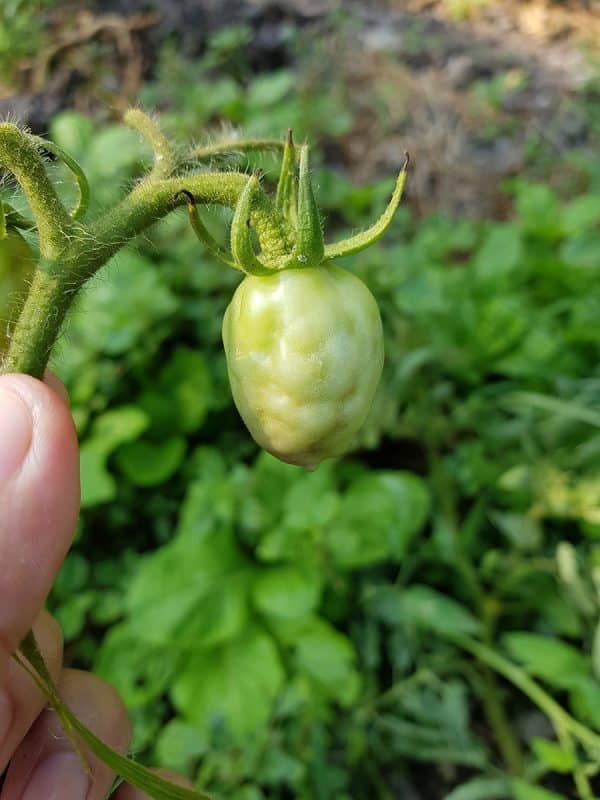
The mosaic virus attacks all kinds of plants, but it’s one of the most common tomato diseases. It doesn’t kill your plant but greatly decreases the number and quality of fruits that you’ll receive. It causes light green and yellow markings on the leaves and mottling on the fruits.
This virus enters through cuts in the leaves and stems. Since it’s a virus, there is no way to treat it. Don’t try to apply fungicides; they won’t work for viral diseases. Don’t save seeds from the infected crops and hope for a better year the next growing season!
7. Septoria Leaf Spot
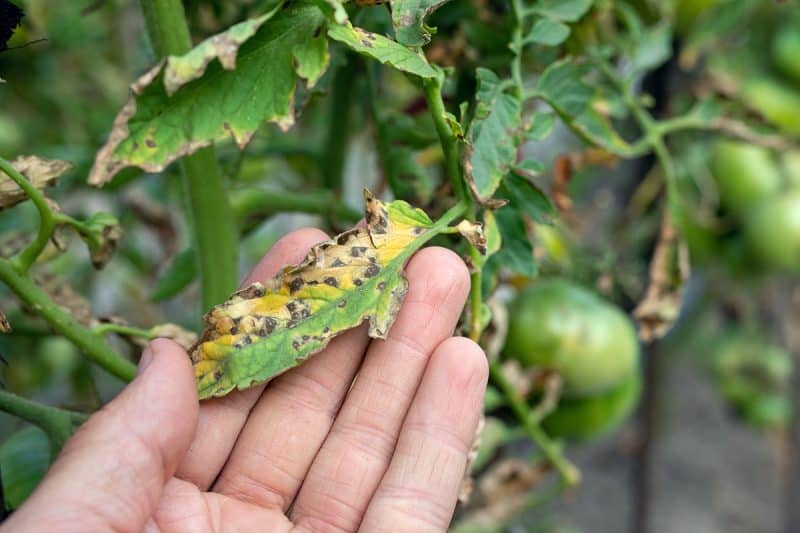
If you find tiny, round splotches on your leaves, you might have septoria leaf spot, a tomato disease caused by Septoria lycopersici. The spots have dark brown edges, and they’ll cover your leaves, which will eventually turn yellow and fall off of the plant.
Preventative measures work well to stop this disease from taking over your garden. Remove tomato plants and debris at the end of the season take away places for the disease to overwinter. Cut off and destroy infected leaves, and always disinfect any equipment that touched the diseased plant.
If your plants end up infected with septoria leaf spot, use an organic fungicide based on copper. These are most effective!
8. Stemphylium Gray Leaf Spot
Gray leaf spot affects the tomato plant leaves, starting with the oldest leaves, but it also infers the stems. It won’t bother the fruits. The leaves develop small, dark spots on both the top and bottom surfaces. The spots are brown with yellow halos that gradually enlarge and turn grayish brown.
Removing all of the infected plants and debris helps to prevent this disease from spreading in the future. It’s most common in cherry and grape tomato plants.
Treating this fungal infection is possible with an early-season fungicide. Using a fungicide as soon as you spot the symptoms is essential for getting rid of it.
9. Southern Bacterial Wilt
Southern bacterial wilt is one of the fastest spreading tomato diseases, and once it hits your garden, it’s unbelievably destructive. It’s caused by the bacteria Ralstonia solanacearum that lives in the soil-borne, traveling by soil, water, plant debris, tools, and more.
At first, southern bacterial wilt shows up as a few wilting leaves, but eventually, more leaves wilt and turn yellow until all wilt and die. If you cut into the stems, slimy ooze comes out, and milky streams come out if you put the stems into water.
There is no cure for this disease. You have to remove infected plants immediately and discard of them. You can prevent the disease by pruning tomato plants to increase air circulation and decrease humidity among the plants.
10. Verticillium Wilt
Verticillium wilt is a fungal infection caused by pathogens in the Verticillium spp. family. This fungus blocks vascular tissue in the plant, causing the leaves and stems to wilt. The symptoms progress slowly until the entire plant yellows and wilts. If you cut into the stem, you’ll see dark brown discoloration.
Once the fungi infect the soil, there is nothing you can do to stop the infection that year, so the best thing you can do is stop it from spreading in future years. Soil solarization kills the fungal spores in the top inches of soil and planting crop rotation is helpful.
How to Prevent Tomato Diseases
Preventing tomato diseases is far easier than treating them. Many diseases have no treatment options, so you need to learn the best preventative methods to keep your tomato plants healthy and happy.
1. Rotate Crops
Many pathogens live in the soil, so don’t plant tomatoes in the same spot each year. Not all diseases affect all types of plants, so rotating keeps diseases at bay.
2. Remove Lower Leaves and Branches
Take off the lower leaves and branches from your tomato plant to prevent them from touching the soil. This is one way that soil-dwelling bacteria enter your plants. Removing branches also helps to increase air circulation around your plant, an essential step to reduce the risk of a fungal infection.
3. Water at the Base of Your Plant
Keeping the foliage dry is essential, so use a soaker hose or hand irrigation that lets you water at the base of your plants. Sprinkler and overhead watering splash soil onto your plant.
4. Mulch Your Tomato Plants
Always mulch around your tomato plants at the start of the season. Lay down two inches of compost, straw, hay, or leaf mold around your plants. Doing this stops soil-dwelling fungal spores from getting onto the lower leaves of your plants.
5. Remove All Debris
At the end of the growing season, remove all debris, especially any diseased tomato plant debris. Burn or toss the debris into the trash to stop the spread of the diseases. Never put any diseased foliage into the compost pile.
Keeping your tomato plants healthy helps to reduce the risk of tomato diseases. If your plants contract a disease, take time to correctly identify the disease and determine if the disease is treatable. Many diseases can be treated with fungicides or other sprays available at local garden centers.
